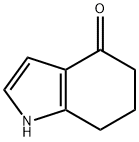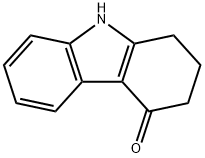1,5,6,7-TETRAHYDRO-4H-INDOL-4-ONE
Synonym(s):4,5,6,7-Tetrahydro-4-oxoindole;NSC 131681
- CAS NO.:13754-86-4
- Empirical Formula: C8H9NO
- Molecular Weight: 135.16
- MDL number: MFCD00075438
- SAFETY DATA SHEET (SDS)
- Update Date: 2023-11-08 17:00:29

What is 1,5,6,7-TETRAHYDRO-4H-INDOL-4-ONE?
The Uses of 1,5,6,7-TETRAHYDRO-4H-INDOL-4-ONE
1,5,6,7-Tetrahydro-4H-indol-4-one, is a versatile building block used for the synthesis of more complex pharmaceutical compounds. It can be used for the preparation of Psammopemmin A.
The Uses of 1,5,6,7-TETRAHYDRO-4H-INDOL-4-ONE
• ;Reactant in synthesis of psammopemmin A as antitumor agent1• ;Reactant in synthesis of a 1,3,4,5-tetrahydrobenzindole β-ketoesters and tricyclic tetrahydrobenzindoles via C-H insertion reactions2• ;Reactant in preparation of tricyclic indole and dihydroindole derivatives as inhibitors of guanylate cyclase3• ;Reactant in preparation of condensed pyrroloindoles via Pd-catalyzed intramolecular C-H bond functionalization of (halobenzyl)pyrroles4• ;Reactant in enantioselective preparation of arylalkenyl indoles via asymmetric C-H insertion of rhodium carbenoids foll
General Description
Iodination of 1,5,6,7-tetrahydro-4H-indol-4-one using 1-chloromethyl--4-fluoro-1,4-diazoniabicyclo[2.2.2]octane bis(tetra-fluoroborate) yields α-iodo derivative as the main product.
Properties of 1,5,6,7-TETRAHYDRO-4H-INDOL-4-ONE
| Melting point: | 188-190 °C (lit.) |
| Boiling point: | 311℃ |
| Density | 1.216 |
| Flash point: | 150℃ |
| storage temp. | under inert gas (nitrogen or Argon) at 2–8 °C |
| form | powder to crystal |
| pka | 15.91±0.20(Predicted) |
| color | White to Light yellow to Light orange |
| CAS DataBase Reference | 13754-86-4(CAS DataBase Reference) |
Safety information for 1,5,6,7-TETRAHYDRO-4H-INDOL-4-ONE
| Signal word | Warning |
| Pictogram(s) |
 Exclamation Mark Irritant GHS07 |
| GHS Hazard Statements |
H315:Skin corrosion/irritation H319:Serious eye damage/eye irritation H335:Specific target organ toxicity, single exposure;Respiratory tract irritation |
| Precautionary Statement Codes |
P261:Avoid breathing dust/fume/gas/mist/vapours/spray. P264:Wash hands thoroughly after handling. P264:Wash skin thouroughly after handling. P271:Use only outdoors or in a well-ventilated area. P280:Wear protective gloves/protective clothing/eye protection/face protection. P302+P352:IF ON SKIN: wash with plenty of soap and water. P305+P351+P338:IF IN EYES: Rinse cautiously with water for several minutes. Remove contact lenses, if present and easy to do. Continuerinsing. |
Computed Descriptors for 1,5,6,7-TETRAHYDRO-4H-INDOL-4-ONE
New Products
4-AMINO-TETRAHYDRO-PYRAN-4-CARBOXYLIC ACID HCL 4-(Dimethylamino)tetrahydro-2H-pyran-4-carbonitrile 4-Aminotetrahydropyran-4-carbonitrile Hydrochloride (R)-3-Aminobutanenitrile Hydrochloride 3-((Dimethylamino)methyl)-5-methylhexan-2-one oxalate 1,4-Dioxa-8-azaspiro[4.5]decane 5-Bromo-2-nitropyridine Nimesulide BP Aceclofenac IP/BP/EP Diclofenac Sodium IP/BP/EP/USP Mefenamic Acid IP/BP/EP/USP Ornidazole IP Diclofenac Potassium THOMAIND PAPER PH 2.0 TO 4.5 1 BOX BUFFER CAPSULE PH 9.2 - 10 CAP SODIUM CHLORIDE 0.1N CVS ALLOXAN MONOHYDRATE 98% PLATINUM 0.5% ON 3 MM ALUMINA PELLETS (TYPE 73) LITHIUM AAS SOLUTION 2-Bromo-1-(bromomethyl)-3-chloro-5-nitrobenzene 2-Bromo-3-nitroaniline N-(3-Hydroxypropyl)-N-methylacetamide 3-Bromo-6-chloropyridazine 4-ethyl-3-nitrobenzoic acidRelated products of tetrahydrofuran








You may like
-
 1,5,6,7-Tetrahydro-4H-indol-4-one CAS 13754-86-4View Details
1,5,6,7-Tetrahydro-4H-indol-4-one CAS 13754-86-4View Details
13754-86-4 -
 1,5,6,7-Tetrahydro-4H-indol-4-one CAS 13754-86-4View Details
1,5,6,7-Tetrahydro-4H-indol-4-one CAS 13754-86-4View Details
13754-86-4 -
 1823368-42-8 98%View Details
1823368-42-8 98%View Details
1823368-42-8 -
 2-(3-(tert-butyl)phenoxy)-2-methylpropanoic acid 1307449-08-6 98%View Details
2-(3-(tert-butyl)phenoxy)-2-methylpropanoic acid 1307449-08-6 98%View Details
1307449-08-6 -
 Ethyl 3-(furan-2-yl)-3-hydroxypropanoate 25408-95-1 98%View Details
Ethyl 3-(furan-2-yl)-3-hydroxypropanoate 25408-95-1 98%View Details
25408-95-1 -
 2-Chloro-5-fluoro-1-methoxy-3-methylbenzene 98%View Details
2-Chloro-5-fluoro-1-methoxy-3-methylbenzene 98%View Details
1805639-70-6 -
 1784294-80-9 98%View Details
1784294-80-9 98%View Details
1784294-80-9 -
 Lithium ClavulanateView Details
Lithium ClavulanateView Details
61177-44-4